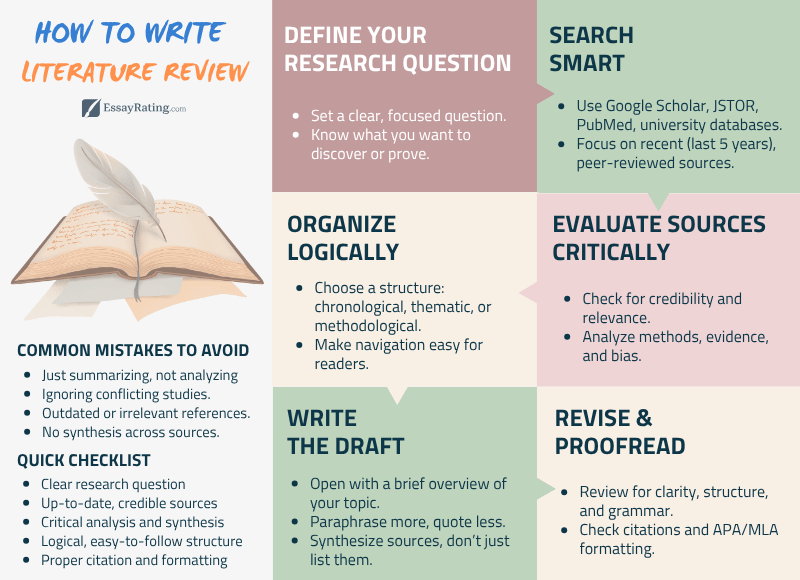How to Write a Literature Review:
Step-by-Step Guide & Mistakes to Avoid
Last updated: March 21, 2025 • 6 min read

Writing a literature review in 2025 isn’t just about summarizing sources—it’s a critical analysis and synthesis of current knowledge on your chosen topic. Many students underestimate its importance, often seeing it as merely a box to tick. In reality, a strong literature review establishes your credibility, demonstrates your understanding, and sets the foundation for your research.
Why Is a Literature Review Crucial in 2025?
A literature review situates your research within the existing scholarship, showcasing how your work fills gaps or extends current studies. Universities in 2025 emphasize literature reviews more than ever, using them as benchmarks to evaluate students’ research skills, analytical thinking, and ability to synthesize information.
Moreover, due to advancements in AI detection and plagiarism software, your literature review must demonstrate genuine analysis and original writing. Superficial summaries or AI-generated texts easily get flagged, potentially jeopardizing your academic integrity.
Step-by-Step Guide to Writing Your Literature Review

Step 1: Define Your Research Question Clearly
The first step is to establish a clear, focused research question. Narrowing your scope helps guide your search and prevents overwhelming yourself with irrelevant literature. Ask yourself: what precisely am I trying to answer or achieve through this review?
Step 2: Conduct Thorough Literature Searches
Use credible databases like Google Scholar, JSTOR, PubMed, and your university’s digital library. Utilize recent publications (ideally within the last five years) and reputable, peer-reviewed journals.
As you gather literature, organize your findings using digital tools like Zotero or Mendeley, which simplify citation management and help avoid losing key references.
Step 3: Evaluate Your Sources Critically
Not every source you find is equally valuable. Critically analyze each article or book for credibility, relevance, and quality. Assess author credentials, research methodologies, biases, and the strength of evidence provided.
Remember, the aim is not to agree or disagree with sources blindly, but to engage critically with their content and methodology.
Step 4: Organize the Literature Review Logically
A well-structured literature review demonstrates clarity and ease of navigation. Consider organizing it chronologically, thematically, or methodologically. Each approach depends on your specific research question and discipline.
Step 5: Write Your Literature Review Draft
Start your draft clearly and concisely, summarizing your research area. Use direct quotations sparingly, preferring to paraphrase or summarize to demonstrate deeper understanding. Always integrate your sources cohesively rather than merely listing them.
Step 6: Revise and Proofread Thoroughly
Revision is crucial. Review your text multiple times for coherence, organization, grammar, punctuation, and APA or MLA formatting consistency. Utilize software tools or professional editing services to ensure maximum accuracy and readability.
Common Literature Review Mistakes Students Make in 2025
- Over-reliance on summaries: Merely summarizing articles without critique weakens your literature review.
- Ignoring contradictory studies: Address conflicting views or findings, demonstrating intellectual honesty.
- Insufficient synthesis: Simply listing sources doesn’t demonstrate critical thinking. Synthesize by discussing relationships between different studies.
- Outdated references: Use the most current literature to reflect contemporary scholarship and avoid outdated information.
Friction Moments: Real Challenges Students Face Writing Literature Reviews
Literature reviews can be deceptively challenging. Students often report difficulty balancing breadth and depth, getting overwhelmed by numerous sources, or struggling to synthesize contradictory findings effectively.
One postgraduate student from Oxford shared:
“I initially treated my literature review like an annotated bibliography. It was only after feedback from my advisor that I realized the importance of synthesizing and critically analyzing each source.”
Checklist: Ensure Your Literature Review Meets 2025 Standards
- Your research question clearly defined and focused.
- All references current, credible, and relevant.
- Critical evaluation and synthesis of sources clearly demonstrated.
- Structure logical, coherent, and easy to follow.
- APA or MLA formatting consistently applied.
Frequently Asked Questions
Essay Services You May Like




